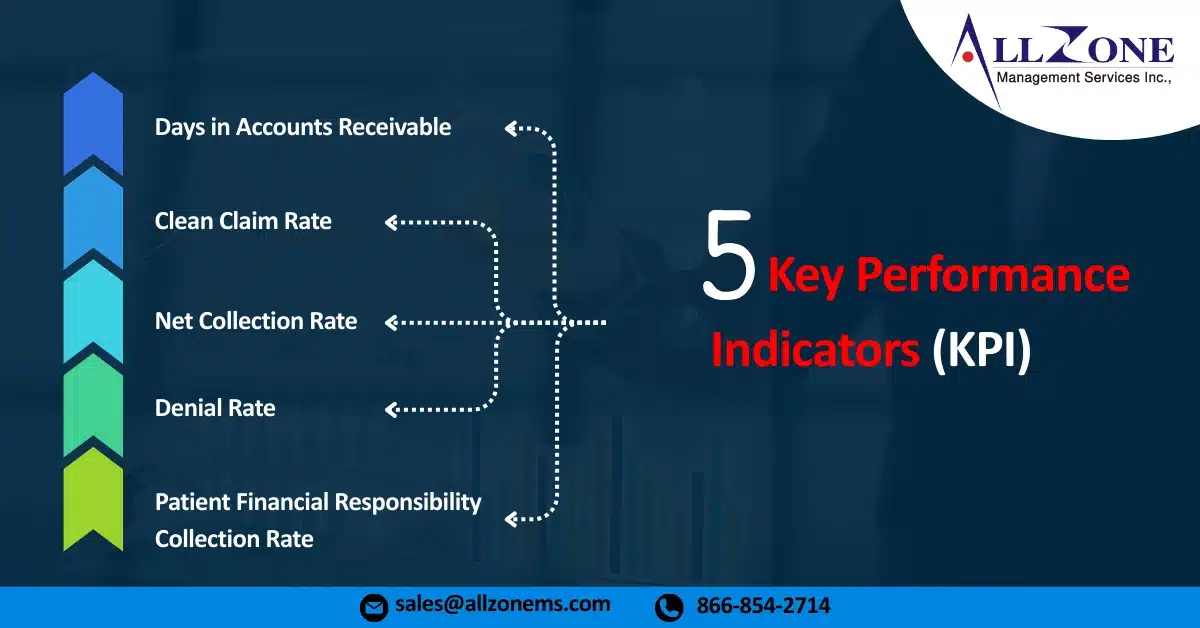In today’s complex healthcare environment, revenue cycle management (RCM) has become more critical than ever. As patient expectations evolve and regulatory requirements grow more stringent, the pressure on RCM leaders to ensure financial sustainability while maintaining high-quality patient care is immense. With tight margins and rising operational costs, understanding and optimizing the right RCM KPIs can make the difference between thriving and merely surviving.
For 2025, healthcare organizations must adopt a more strategic approach to revenue cycle management. This means moving beyond traditional metrics and embracing RCM KPIs that provide actionable insights, align with organizational goals, and drive continuous improvement. Below, we explore the Top 5 KPIs every RCM leader should track this year to ensure operational efficiency, financial health, and enhanced patient satisfaction.
1. Days in Accounts Receivable (A/R)
Why it matters: Days in A/R is one of the most critical metrics in healthcare revenue cycle management. It measures the average number of days it takes for a provider to collect payments after a service has been rendered. A lower number typically indicates more efficient billing and collections processes.
What to track:
- Total A/R Days (goal: under 40 days for most practices)
- A/R aging buckets (0-30, 31-60, 61-90, 91-120, 120+ days)
- Percentage of A/R over 90 days
Strategies for improvement:
- Streamline claim submission processes to reduce delays
- Automate follow-ups and reminders
- Conduct regular audits to identify bottlenecks
Tip: Use predictive analytics to identify accounts likely to age beyond 90 days and prioritize them for follow-up.
2. Clean Claim Rate (CCR)
Why it matters: The Clean Claim Rate represents the percentage of claims that pass through the system and get paid without requiring manual intervention. A high CCR reduces the administrative burden and improves cash flow.
What to track:
- Percentage of claims paid without edits or rejections (goal: 90% or higher)
- Common denial reasons
- Claim edit trends over time
Strategies for improvement:
- Implement real-time eligibility verification
- Train staff on proper coding and documentation
- Use RCM software with intelligent claim scrubbing features
Tip: Regularly review denied claims to identify patterns and implement corrective training or process improvements.
3. Net Collection Rate (NCR)
Why it matters: Net Collection Rate indicates how effectively an organization collects reimbursements compared to the amount it is contractually owed. Unlike gross collection rate, NCR accounts for contractual adjustments, providing a more accurate reflection of performance.
What to track:
- Total payments collected / (Total charges – contractual adjustments)
- Target NCR: 95% or higher
Strategies for improvement:
- Improve payer contract management
- Identify and address underpayments
- Enhance patient payment processes and transparency
Tip: Monitor payer performance and identify payers with frequent discrepancies or delayed payments.
4. Denial Rate
Why it matters: Denials represent lost or delayed revenue and require additional resources to resolve. A high denial rate indicates underlying issues in billing, documentation, or eligibility verification.
What to track:
- Percentage of total claims denied (goal: under 5%)
- First-pass denial rate
- Denials by reason and payer
Strategies for improvement:
- Conduct root cause analysis of denials
- Implement pre-bill reviews and edit checks
- Use denial management tools to automate appeals
Tip: Establish a cross-functional team to regularly review denial trends and update internal policies and training accordingly.
5. Patient Financial Responsibility Collection Rate
Why it matters: As high-deductible health plans become more common, a growing share of healthcare revenue now comes directly from patients. Tracking how effectively your organization collects this portion is essential to financial health.
What to track:
- Amount collected at point of service
- Outstanding balances post-visit
- Average time to collect from patients
Strategies for improvement:
- Offer multiple, easy-to-use payment options
- Provide upfront cost estimates and financial counseling
- Implement digital tools like mobile billing and patient portals
Tip: Engage patients early in the financial process to set clear expectations and improve collection rates.
Integrating KPIs into Daily Operations
Tracking KPIs is only the first step. The real power lies in using this data to drive informed decision-making. RCM leaders should:
- Create dashboards for real-time monitoring of these KPIs
- Schedule regular reviews to evaluate trends and set benchmarks
- Engage staff by aligning performance metrics with team goals
- Invest in technology that provides actionable insights and automates manual processes
Additionally, consider implementing a continuous improvement framework such as Lean or Six Sigma to systematically identify inefficiencies and track the impact of changes over time.
Looking Ahead: Future Trends in RCM KPIs
With advances in AI, machine learning, and data analytics, RCM KPIs are evolving. In the near future, leaders can expect:
- Predictive analytics to forecast payment risks and patient behavior
- Advanced segmentation of payer performance and patient demographics
- Integrated financial and clinical KPIs for a more holistic view of performance
Proactively adapting to these trends will ensure your organization remains competitive and resilient in an increasingly challenging healthcare landscape.
For RCM leaders, 2025 presents both significant challenges and opportunities. By focusing on the right KPIs—Days in A/R, Clean Claim Rate, Net Collection Rate, Denial Rate, and Patient Financial Responsibility Collection Rate—organizations can not only optimize revenue but also enhance the patient experience and prepare for future demands.
The path to high performance begins with clarity. By consistently tracking and acting on RCM KPIs, revenue cycle management leaders gain invaluable insights into their operations. These key performance indicators provide a clear lens through which to monitor crucial aspects like clean claim rate, denial rate, and days in accounts receivable, enabling them to drive measurable results and lead their organizations toward long-term financial health and operational excellence.
Stay focused, stay informed, and let data guide your success.

